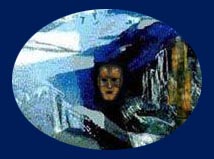
THE WAY NORTH
Joel Weishaus
"The
Way North is the Way into the Unknown."
-Herbert
Read
During
the last Ice Age, Homo sapiens were tested as to whether
they could survive extreme climatic conditions. Not only did our
ancestors survive,
they generated an art that has never been surpassed on the scale
of its multimedia daring. They also created |
 |
symbolic
space, the dimension in
which North is "a
mode of perception which raises it to the power of a symbol, to being
a symbolic direction, that is, to a dimension
beyond."1
This
dimension is "with us from any latitude, close
by any season and surrounding
heat."2 |
|
After Glenn Gould, virtuoso Canadian musician, raised "The Idea of North" on a radio show, it was elaborated by composer R. Murray Schafer, was an art exhibition,3 and is discussed in myriad books, while far off I see the threads of life twisting themselves in the intricate web which stretches unbroken from life’s sweet morning dawn to the eternal death-stillness of the ice. Thought follows thought---you pick the whole to pieces, and melting glaciers and sea-ice loom as global disaster. This is a time of preparation, of sorting through myths and motifs, old and new, too heavy to carry across vast inhospitable spaces. Man-made structures buckle under the irony of thawing permafrost, releasing more heat-capturing gases into the swelter of lengthening summers, creating a circle of stories disappearing along with human ways of life "the way in which archetypes link actual symbolism to psychic functioning through time and space."4 There is a voluminous history of explorers who sailed the Arctic Sea and trekked across its barren lands. Now a new breed of explorer/anthropologist, climatologist , journalist, and artist has been flying to the part that’s left over, which gets thrown away in Western culture...the most holy part in shamanic rituals. What’s left over represents the debt, the hollowness that’s been carved out of the universe by human ingenuity, and so must be refilled with "the idea of something very powerful, very primal."5 So, Go on! Go on! There is no place left.6
Contents
|
|
|
Except for lower right,
images are from: N. Hallendy, |
| 1-
H. Corbin, The Man of Light in Iranian
Sufism. Boulder, 1978.
Thank you to the people
who
read these pages while they were in progress; especially to Anny Ballardini. |